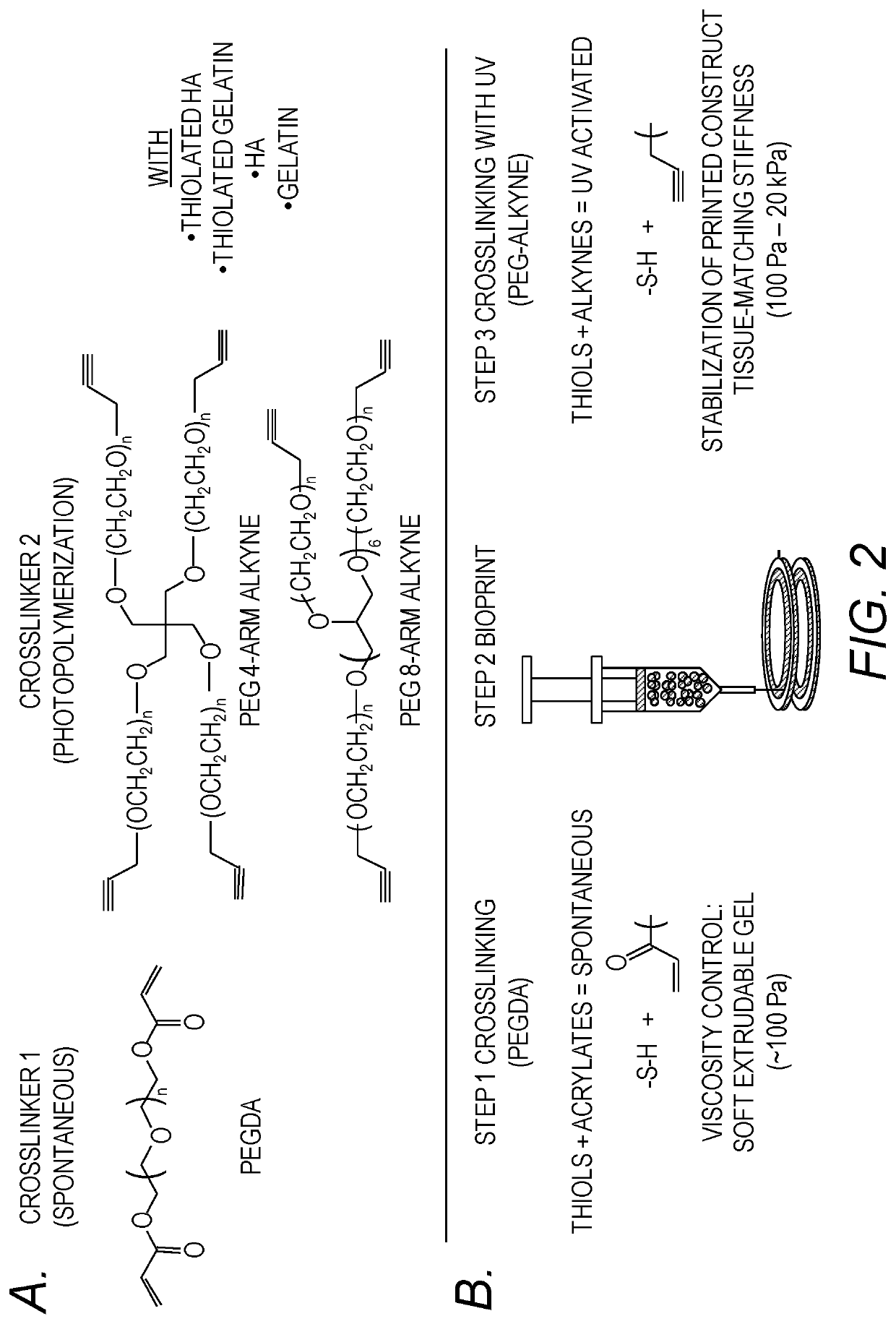Compositions, cell constructs, and methods of making and using the same
a cell and cell technology, applied in the field of compositions, cell constructs, and methods of making and using the same, can solve the problems of difficulty in producing desired constructs, interfacing between deposition/fabrication hardware, and standard hydrogel design problems, so as to increase the stiffness of the end product, increase the ability to maintain viable cells in culture, and increase the effect of functionality
- Summary
- Abstract
- Description
- Claims
- Application Information
AI Technical Summary
Benefits of technology
Problems solved by technology
Method used
Image
Examples
example 1
Materials and Methods
[0128]Materials. Hydrochloric acid (HCl) was from Fischer Scientific (Houston, Tex.). Pepsin (porcine gastic mucosa) was from Sigma Aldrich (St. Louis, Mo., USA). Heprasil (est. 160 kDa MW), Gelin-S, and Extralink (PEGDA, 3.4 kDa MW) were used from HyStem-HP hydrogel kits from ESI-BIO (Alameda, Calif., USA). PEG 4-Arm Acrylate (10 and 20 kDa MW), PEG 4-Arm Alkyne (10 kDa MW), and PEG 8-Arm Alkyne (10 kDa MW) were from Creative PEGWorks (Winston-Salem, N.C., USA).
[0129]Preparation of tissue-specific extracellular matrix (ECM) digest. Tissue-specific ECM digest solutions were prepared as previously described for liver (A. Skardal, L. Smith, S. Bharadwaj, A. Atala, S. Soker and Y. Zhang, Biomaterials, 33, 4565 (2012).). Fresh liver, cardiac, or skeletal muscle tissue was rinsed with chilled Dulbecco's phosphate buffered saline (DPBS). The tissues were cut into 10 cm by 0.5-1.0 cm strips and minced with surgical scalpels. Minced tissue was transferred to 500 ml dist...
example 2
[0154]Glioblastoma (GBM) is a cancer of the brain that despite maximal therapy and surgery infiltrates normal brain and recurs in most patients. Unfortunately, only few 3D in vitro models of GBM exist that faithfully recapitulate the tumor architecture and microenvironment seen in vivo in humans. To address this limitation, we have developed a 3D brain tumor organoid model using a hydrogel that mimics both the composition and mechanical properties of brain extracellular matrix (ECM). The cell lines U138, A172 and U373 were formed into spheroids and encapsulated in hyaluronic acid / gelatin ECM hydrogel. We studied tumor growth, invasion distances and velocities, proliferation, and viability as effects of conditions including Wnt signaling manipulation and different matrix stiffnesses using MTS assays, microscopy, and confocal imaging. WNT modulated environments led to marked decreased migration in U138 spheroids with changes in cell morphology. In different stiffness environments we o...
example 3
[0166]In a 96 well plate, we placed 10,000 cells on two sets of nine wells of 50 ul PEGSSDA hydrogel and the wells were filled with DMEM high glucose and cultured for a week. On day 4, one set of gels were softened using NAC 100 mmol for 60 minutes. Now proliferation of cells was compared between contol gels and softened gels using MTS assays on day 7.
[0167]In a 96 well plate, we placed 10,000 cells on two sets of nine wells of 50 ul S3 stiff hydrogel and the wells were filled with DMEM high glucose and cultured for a week. On day 4, one set of gels were softened using collagenase (1:10 dilution) for 10 minutes. Now proliferation of cells was compared between contol gels and softened gels using MTS assays on day 7.
[0168]The results demonstrated that the stiffness sensitivity of the cells could be harnessed as a therapeutic option in the treatment of GBM. Reduced proliferation was seen in gels softened with NAC. To adapt it more clinically, collagenase was used to soften the gels and...
PUM
| Property | Measurement | Unit |
|---|---|---|
| diameter | aaaaa | aaaaa |
| diameter | aaaaa | aaaaa |
| diameter | aaaaa | aaaaa |
Abstract
Description
Claims
Application Information
 Login to View More
Login to View More - R&D
- Intellectual Property
- Life Sciences
- Materials
- Tech Scout
- Unparalleled Data Quality
- Higher Quality Content
- 60% Fewer Hallucinations
Browse by: Latest US Patents, China's latest patents, Technical Efficacy Thesaurus, Application Domain, Technology Topic, Popular Technical Reports.
© 2025 PatSnap. All rights reserved.Legal|Privacy policy|Modern Slavery Act Transparency Statement|Sitemap|About US| Contact US: help@patsnap.com



